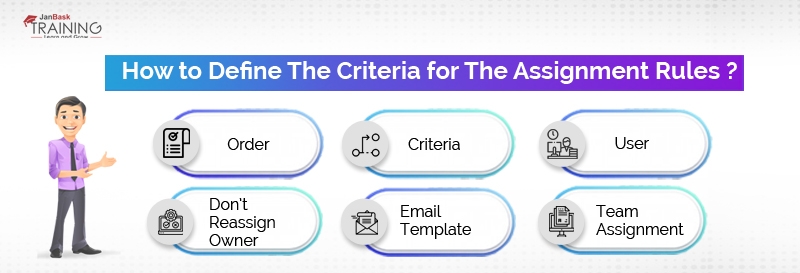Introduction
An assignment rule in Salesforce is used to define to whom case or lead is assigned based on the specified criteria. Most of the organizations have one particular rule for the overall purpose. For example, there could on lead assignment rule for web-generated leads and one case assignment rule for the holiday use.
Two-ways to define assignment rules
Typically, only one rule will be effective at a particular time span. Assignment rules in organizations are used to automate the lead generation process and support the business processes too. Here, are the two popular ways how can you define the assignment rules in Salesforce.
Lead Assignment Rules
This rule will dictate you how leads are assigned to the users and how to create them manually. They could be either web-generated or data can be imported through Wizard as well.
Case Assignment Rules
This will rule specify how cases can be assigned to the users that are arranged in queues or created manually. However, there are plenty of techniques for data generation like email, web, portals, Outlook or Lotus Notes etc.
For each rule type, there could be multiple entries that will tell you exactly how leads or cases can be assigned. Each of the entries for the rule will be discussed later and you will get a clear idea of how to set up, create, or manage assignment rules within Salesforce.
Assignment Rule Creation in Salesforce
To start with, you must have the professional, developer, or enterprise edition of the Salesforce. Other than this, versions won’t help in the rule creation. Further, you should check that you are permitted to define the assignment rules with the ‘customize application’ option. The best idea is to speak to your Admin before you continue.
- To create an assignment rule, go to the Set up First and type Assignment Rules in the Quick Find box. After this, you may select either lead assignment rules or case assignment rules based on the requirements.
- Now select the new entry and give a proper name to the rule. You should specify if you wanted to continue with leads or cases with automated or manual operations. Once you have defined everything clearly then click on the Save option in the end.
- After this, you will be asked to define the criteria for the rule. Go to the rule entries and click on the New button. Congratulations, the assignment rule has been created successfully.
- The next step comes how can we view or edit the assignment rules. If you wanted to edit the name of the rule then click on the Rename option next to the rule name. in this way, this is possible for you to edit the rule name.
- To edit the rule entries, first, choose the rule name from the list of rules. Now click New to add an entry, you can either Add or Delete rule entry or select reorder to change the order of rule entries as needed.
With this discussion, you are familiar with all the basic steps for creating an assignment rule within Salesforce. Still, we are not sure how to define criteria for a rule in detail. Let us dive deep and discuss the different rule entries in detail below.
How to define the criteria for the assignment rules?

- Order – Here, you can define the order of how entries should be processed in a queue. Salesforce will evaluate each particular entry and as soon as the criteria are matched, the entry will be executed otherwise it will be reassigned.
- Criteria – It includes the special conditions that should be matched by leads or cases to be assigned. For example, if your organization is using multiple languages then you can set the default language, add up to 25 filter criteria with 255 characters each. As soon as you pick the filter criteria then the selected values will be stored in the default language as given earlier. If you wanted to edit, delete or evaluate the existing filter criteria then don’t forget to set the default language on the Company Info page otherwise it will not work as usual as expected. You can also set custom conditions like true or false where the rule will be operated automatically based on the specified conditions.
- User: This is the name to who lead or case is assigned recently. We could not specify users inactive here and you should define the read permissions on leads or cases.
- Don’t Reassign Owner: It specifies the name of the current owner and It could not be changed if the rule is modified or updated.
- Email Template: it will decide on the email template that will be used for the new owner. There are plenty of pre-ready email templates that can be used based on the purpose and nature of the information stored in email. In case, the template is not defined then the email will not be sent to the users. If this filed is defined properly then the notification will go to all assigned members.
- Team assignment – Here, you can members of a team suitable for the project. Add a new row to dictate the predefined case teams. You can also replace the predefined case teams if any particular condition matches.
Once you have defined the rule entry and criteria properly as discussed above, click on save option and Save & New option to create more entries. Assignment rules are highly complicated in general and difficult to understand without any proper knowledge and background. With this blog, you have a complete idea of assignment rules, how to create, manage, or set up assignment rules within Salesforce. A depth understanding of the topic will help you to define the rule professionally as needed by the business organization.
Learn Salesforce in the Easiest Way
- Learn from the videos
- Learn anytime anywhere
- Pocket-friendly mode of learning
- Complimentary eBook available
Conclusion
When defined correctly, they do bring really powerful and flexible logic to an already robust CRM. If you wanted to know more about assignment rules in Salesforce or workflow rules, salesforce objects then you should join the Salesforce Certification program at JanBask training right away and learn to practice different concepts in Salesforce by expert mentors.
Introduction
Salesforce Vs. Different Technologies
Interview
Salesforce Course
Upcoming Batches
Trending Courses
Cyber Security
- Introduction to cybersecurity
- Cryptography and Secure Communication
- Cloud Computing Architectural Framework
- Security Architectures and Models
Upcoming Class
0 day 30 Dec 2025
QA
- Introduction and Software Testing
- Software Test Life Cycle
- Automation Testing and API Testing
- Selenium framework development using Testing
Upcoming Class
-1 day 29 Dec 2025
Salesforce
- Salesforce Configuration Introduction
- Security & Automation Process
- Sales & Service Cloud
- Apex Programming, SOQL & SOSL
Upcoming Class
7 days 06 Jan 2026
Business Analyst
- BA & Stakeholders Overview
- BPMN, Requirement Elicitation
- BA Tools & Design Documents
- Enterprise Analysis, Agile & Scrum
Upcoming Class
10 days 09 Jan 2026
MS SQL Server
- Introduction & Database Query
- Programming, Indexes & System Functions
- SSIS Package Development Procedures
- SSRS Report Design
Upcoming Class
10 days 09 Jan 2026
Data Science
- Data Science Introduction
- Hadoop and Spark Overview
- Python & Intro to R Programming
- Machine Learning
Upcoming Class
3 days 02 Jan 2026
DevOps
- Intro to DevOps
- GIT and Maven
- Jenkins & Ansible
- Docker and Cloud Computing
Upcoming Class
3 days 02 Jan 2026
Hadoop
- Architecture, HDFS & MapReduce
- Unix Shell & Apache Pig Installation
- HIVE Installation & User-Defined Functions
- SQOOP & Hbase Installation
Upcoming Class
3 days 02 Jan 2026
Python
- Features of Python
- Python Editors and IDEs
- Data types and Variables
- Python File Operation
Upcoming Class
4 days 03 Jan 2026
Artificial Intelligence
- Components of AI
- Categories of Machine Learning
- Recurrent Neural Networks
- Recurrent Neural Networks
Upcoming Class
18 days 17 Jan 2026
Machine Learning
- Introduction to Machine Learning & Python
- Machine Learning: Supervised Learning
- Machine Learning: Unsupervised Learning
Upcoming Class
10 days 09 Jan 2026
Tableau
- Introduction to Tableau Desktop
- Data Transformation Methods
- Configuring tableau server
- Integration with R & Hadoop
Upcoming Class
-1 day 29 Dec 2025













